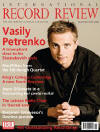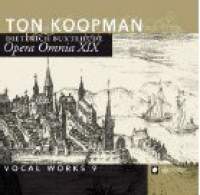Texte paru dans: / Appeared in:
*

International Record Review - (11//2014)
Pour
s'abonner / Subscription information
Challenge Classics
CC72258

Code-barres / Barcode : 0608917225822
Consultez toutes les évaluations recensées pour ce cd
~~~~ Reach all the evaluations located for this CD
Dietrich Buxtehude (c.1637‑1707) is best known today for his organ music (and for his influence on the music of the young Johann Sebastian Bach), but recent research has shown that he was actually a much more prolific composer of sacred vocal music than had been hitherto suspected. He was appointed organist of St Mary's, L(ibeck, in 1668, but the terms of his employment never actually required him to compose vocal music. Yet in common with other ambitious organists in northern and central Germany, Buxtehude put on regular concerts in St Mary's featuring his own organ and vocal music in a series of 'Abendmusiken' (music evenings) held on five consecutive Sundays ‑ the last two in Trinity and the second, third and fourth in Advent. These concerts took place between four and five in the afternoon and, according to a guidebook to Lüibeck of 1697, were relaxed affairs consisting of a succession of 'pleasant vocal and instrumental music'. This is the context for the works included on the present disc ‑ though none can be precisely connected with any particular concert.
The ten pieces collected here reflect the extraordinary diversity of Buxtehude's poetic tastes. There are German and Latin texts taken from the Luther Bible aud Vulgate, alongside Medieval hymns, church hymns as well as modern spiritual poetry. Poetry and prose require quite different musical treatment, but the vast range of styles Buxtehude adopts goes well beyond these considerations, suggesting that he bad a keen sense of the tastes of his audiences arid patrons, and was interested in extending and educating them further.
It's surprising to find Buxtehude setting Thomas Aquinas's Corpus Christi hymn Pange lingua gloriosi, which was excluded from Lutheran worship. It's the finest, most intensely composed piece here, in which the mystery of transubstantiation excites Buxtehude to the use of the highly expressive interval of a tritone (g' to c#') at the start of the introductory instrumental sonata and then again between the repetition of the opening words 'Pange, pange' (Tell, tongue, the mystery of the glorious body'). He doesn't make use of the famous Medieval chant melody associated with the words, but treats the strophic text differently in each of its six verses. The four singers (two sopranos, alto and bass) make maximum capital out of the extra expressive possibilities which Buxtehude's approach thus affords ‑ particularly word painting and rhetorical text repetition. Despite some high‑end distortion around five minutes into the piece and a little pitch instability in the final verse, the cumulative power achieved here by the four singers and five‑part string ensemble is extremely moving, the opening of the work strongly reminiscent of the tortured beauty of Buxtehude's great cantata cycle Membra Jesu of 1680.
I enjoyed not only the unpredictability of Buxtehude's musical forms but also his scoring. There are three solos, two duets, three trios, and a work each for ensembles of four and five singers ‑ all accompanied by consorts of strings mostly in three parts. In the most impressively scored piece, Accedite gentes, accurrite populi, the five‑strong solo ensemble is joined by a ripieno choir for the clinching choral sections. Though it was once usual to perform Buxtehude's more fully scored vocal works with full choirs, scholarly research now suggests that ensembles of solo voices were the norm, though a reinforcing 'ripieno' group may sometimes have been added, though not always singing the same material. The reason for adding the extra weight of the Amsterdam Baroque Choir is a note in the original performing parts which mentions 'ripieni si pace' (ad libitum doubling of violins and violas ‑ presumably to balance the addition of more voices). It's not explained why extra strings are not added too.
In less complicated pieces like the German aria Was mich auf dieser Welt betrübt, each of the three verses of Ahasverus Fritzsch's poem of 1679 are sung to the same music and are separated by a repeated string ritornello. Because it was designed for instant melodic appeal, Amaryllis Dieltiens enunciates clearly and doesn't try to over‑finesse'things. She's a better ensemble singer ‑ blending wonderfully in Pange lingua ‑ but it's not a pin‑sharp voice, and in the limelight she's not always perfectly tonally resolved. But none of the four sopranos really shines on her own, and some are at the centre of a few intrusive intonation, problems. It's not always clear who's singing, but either Miriam Feuersinger or Dorothee Wohlgemuth makes a horribly shrill noise in her solo a third of the way through Ich habe Lust. Bettina Palm, a veteran of Koopman's Buxtehude series, is strained and painfully pitch-approximate in her two lengthy solos, with a particularly hard, harsh tone intruding on the peaceful world of O dulcis Jesu ‑ possibly the result of the high pitch (A=415) adopted by Koopman throughout. Even the usually solid bass Klaus Mertens, that great anchor of Dutch Baroque ensembles, has a few moments of instability.
Overall, more
time spent in preparation and a more attentive producer's ear would have
paid dividends. Nevertheless, this is the penultimate volume of Ton
Koopman's
complete Buxtelmde series, and I very much look forward to
the final instalment later this year.
Fermer la fenêtre/Close window
Cliquez l'un ou l'autre
bouton pour découvrir bien d'autres critiques de CD
Click either button for many other reviews


